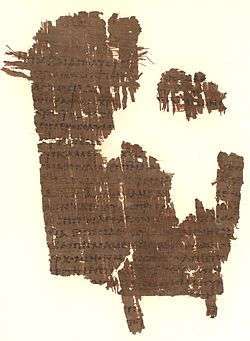Acts 19
| Acts 19 | |
|---|---|
|
Acts 18:27-19:6 on recto side in Papyrus 38, written about AD 250. | |
| Book | Acts of the Apostles |
| Bible part | New Testament |
| Order in the Bible part | 5 |
| Category | Church history |
Acts 19 is the nineteenth chapter of the Acts of the Apostles in the New Testament of the Christian Bible. It records part of the third missionary journey of Paul.[1] The author of the book containing this chapter is anonymous but early Christian tradition uniformly affirmed that Luke composed this book as well as the Gospel of Luke.[2]
Text
The original text is written in Koine Greek and is divided into 41 verses. Some most ancient manuscripts containing this chapter are:
- Papyrus 38 (ca. AD 250)
- Codex Vaticanus (AD 325-350)
- Codex Sinaiticus (AD 330-360)
- Codex Bezae (ca. AD 400)
- Codex Alexandrinus (ca. AD 400-440)
- Codex Laudianus (ca. AD 550)
Locations
This chapter mentions the following places (in order of appearance):
Timeline
This part of the third missionary journey of Paul took place in ca. AD 53-55.[3]
Structure
In the New King James Version, this chapter is sub-divided as:
- Acts 19:1-10 = Paul at Ephesus
- Acts 19:11-20 = Miracles Glorify Christ
- Acts 19:21-41 = The Riot at Ephesus
Verse 4
- Then Paul said, “John indeed baptized with a baptism of repentance, saying to the people that they should believe on Him who would come after him, that is, on Christ Jesus.”[4]
Verse 14
- Also there were seven sons of Sceva, a Jewish chief priest, who did so (i.e. attempted to heal using the name of the Lord Jesus).[5]
Sceva (Greek: Σκευᾶς Skeuas) was a Jew called a "chief priest" (Greek: ιουδαιου αρχιερεως). Some scholars note that it was not uncommon for some members of the Zadokite clan to take on an unofficial high-priestly role, which may explain this moniker.[6] However, it is more likely that he was an itinerant exorcist based on the use of the Greek term (Greek: περιερχομένων perierchomenōn) "going from place to place" in Acts 19:13.[7]
In this verse, it is recorded that he had seven sons who attempted to exorcise a demon from a man in the town of Ephesus by using the name of Jesus as an invocation. This practice is similar to the Jewish practice, originating in the Testament of Solomon of invoking Angels to cast out demons.[7] Sorcery and exorcism are mentioned several times in Acts: Simon Magus and Elymas Bar-Jesus, and divination is illustrated by the girl at Philippi. "She was regarded as spirit-possessed, and it was the spirit who was addressed and expelled by Paul in Acts 16:16-18".[8]
Verse 15
Verse 21
- When these things were accomplished, Paul purposed in the Spirit, when he had passed through Macedonia and Achaia, to go to Jerusalem, saying, “After I have been there, I must also see Rome.”[10]
See also
References
- ↑ Halley, Henry H. Halley's Bible Handbook: an abbreviated Bible commentary, 23rd edition. Zondervan Publishing House. 1962.
- ↑ Holman Illustrated Bible Handbook. Holman Bible Publishers, Nashville, Tennessee. 2012.
- ↑ John Arthur Thomas Robinson (1919-1983). "Redating the New Testament", Westminster Press, 1976. 369 pages ISBN 978-1-57910-527-3
- ↑ Acts 19:4
- ↑ Acts 19:14
- ↑ Jeremias, Joachim (1969), Jerusalem in the Time of Jesus: An Investigation Into Economic & Social Conditions During the New Testament Period, Minneapolis: Fortress Press, p. 193, ISBN 978-1-4514-1101-0, retrieved 2013-03-01
- 1 2 Arnold, Clinton (March 2012), "Sceva, Solomon, and Shamanism: The Jewish Roots of the Problem at Colossae" (PDF), Journal of the Evangelical Theological Society, 55 (1): 7–26, ISSN 0360-8808, retrieved 2013-03-01
- ↑ Encyclopedia of the Bible, 'Magic and Sorcery' https://www.biblegateway.com/resources/encyclopedia-of-the-bible/Magic-Sorcery accessed 6 October 2015
- ↑ Acts 19:15
- ↑ Acts 19:21
